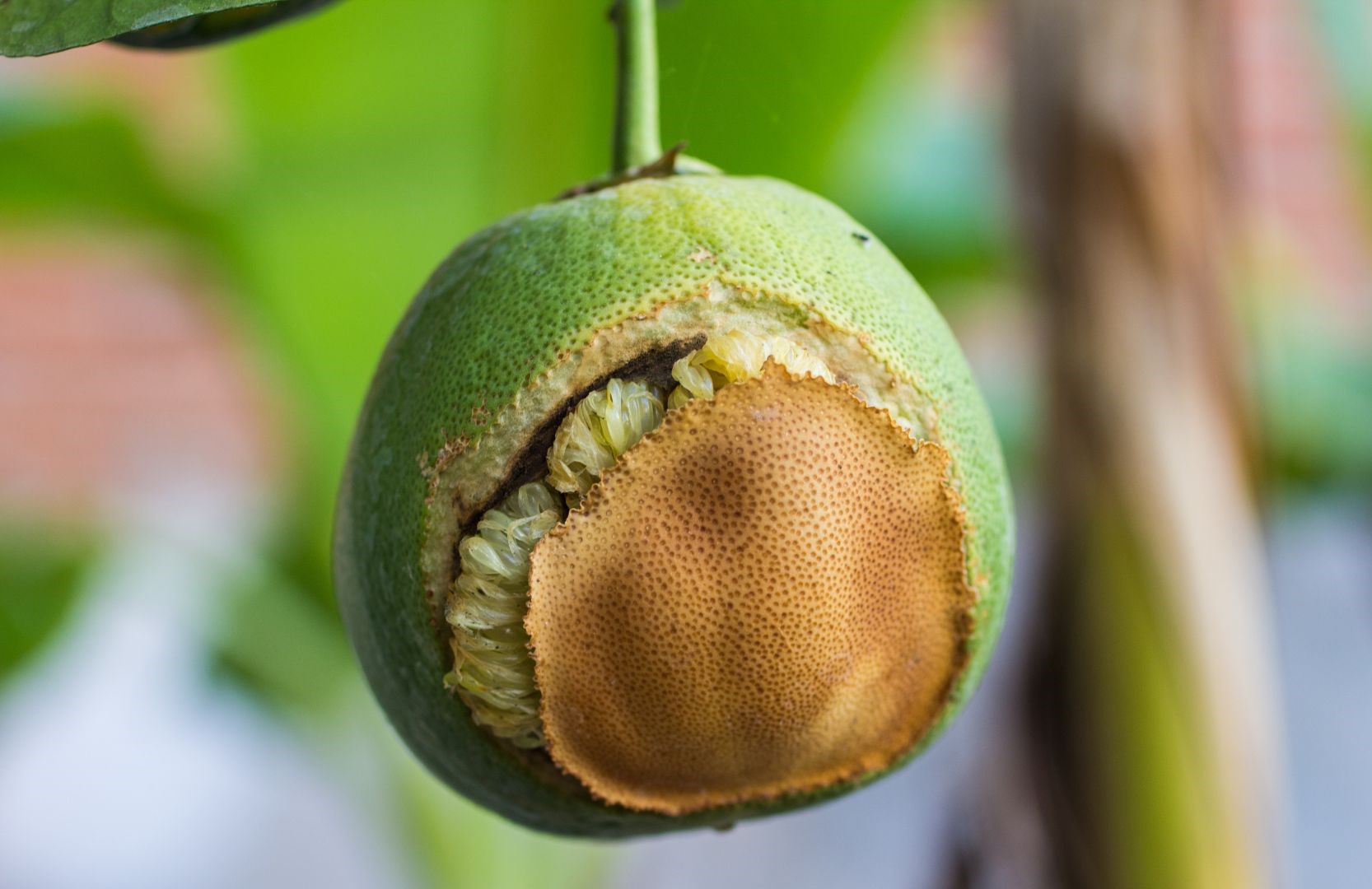Important Citrus Diseases caused by Fungi
Which are the most important fungal diseases that affect citrus trees?
Pre-harvest fungal citrus diseases
1. Foot Rot & Gummosis
What are Citrus Foot Rot and Citrus Gummosis, and how do they infect citrus trees?
Foot rot and gummosis are fungal diseases that affect citrus trees and are caused by Phytophthora species (spp). They lead to severe soilborne infections affecting citrus trees’ roots, trunk, branches, shoots, and fruits worldwide.
Although ten of these fungal species (oomycete species) have been found to be pathogenic on citrus, only three of them induce the most economic damage and include the:
- P. citrophthora common in Mediterranean areas,
- P. nicotianae (syn P. parasitica) in subtropical areas and,
- P. palmivora in subtropical and tropical regions
Regarding their mode of infection, P. nicotianae generally does not infect the above-ground parts of citrus trees. It causes foot rot or gummosis, a bark disease characterized by degraded cambium (the growing part of the trunk, just below the outer and inner bark) and phloem tissue (nutrient transport vessels of trees).
On the other hand, P. palmivora and P. citrophthora lead to gummosis and Brown Rot of the trunk and major limbs of the citrus trees. Vertical cracking of the bark can also be observed. P. citrophthora can attack the fruits, which display brown patches of soft rotten tissue and a foul smell.
Trunk and root rot afflictions are regarded as the most serious on citrus.
- Melanose disease is caused by the fungus Diaporthe citri and exhibits similar symptoms on the fruit. Dark brown to black spots appear on fruit, twigs, and leaves, which are raised and rough. However, the damage is superficial and does not affect internal fruit quality, making this disease less severe than the rest.

The infection cycle of Phytophthora spp. begins with the attraction of fungal spores to citrus roots, which leads to entry into the root tip. Infection of the root results in discoloration, softening of root tissue, and decay of fibrous roots. At this stage, the citrus tree roots appear to show damaged lesions, and Crown Rot (Collar Rot) may also occur. Contrastingly, when the fungal spores enter the tree through wounds or bark cracks, they develop into gummosis and foot rot. Root rot induces water stress, potentially resulting in young citrus trees’ death. Mature trees display reduced vigor, decreased fruit production, and twig dieback. Low-hanging fruits may also become infected from new stems (propagules) during rain splashing. This causes the brown rot of fruits and leaf fall. Disease worsening occurs due to susceptible rootstock, excessive irrigation, high water salt accumulation, or frost.
The lack of immediate action against infected fruits might cause fungal establishment of branch infections and lead to even more twig dieback. Farmers should pay close attention during the rainy season. Soil amendments that increase soil aeration are necessary to prevent the disease. Well-drained soils are a plus since this fungus enters the tree via the root system.
How to detect Phytophthora spp on citrus trees?
The detection involves using leaf and fruit baits, which are then planted onto media to observe morphological characteristics.
How to prevent Phytophthora and treat the infected citrus trees?
- Plant disease-free cuttings and materials in plant nurseries
- Maintain adequate soil drainage
- Use fungicides
- Use resistant rootstocks such as:
- Swingle citrumelo
- Yuma citranges
- African Shaddock x Rubidoux trifoliate orange
- Sour orange
- Rough lemon
- Rangpur lime
- Carrizo and Troyer citranges
Nonetheless, differences in susceptibility and tolerance to individual Phytophthora spp have been reported in different citrus rootstocks. For example, Swingle citrumelo is tolerant to root rot caused by P. nicotianae, but it is susceptible to P. palmivora. Rubidoux trifoliate orange rootstock and Rangpur lime have also shown aggressiveness of P. nicotianae for the last decade. Research suggests that this is due to changing climatic conditions, cultural practices, and the introduction of new rootstocks, i.e., new unknown genotypes in regions. Farmers can use the images below to identify the disease in time for treatment. Regular field observations and soil humidity measurements are also advised. Also, seek the advice of local agronomists.
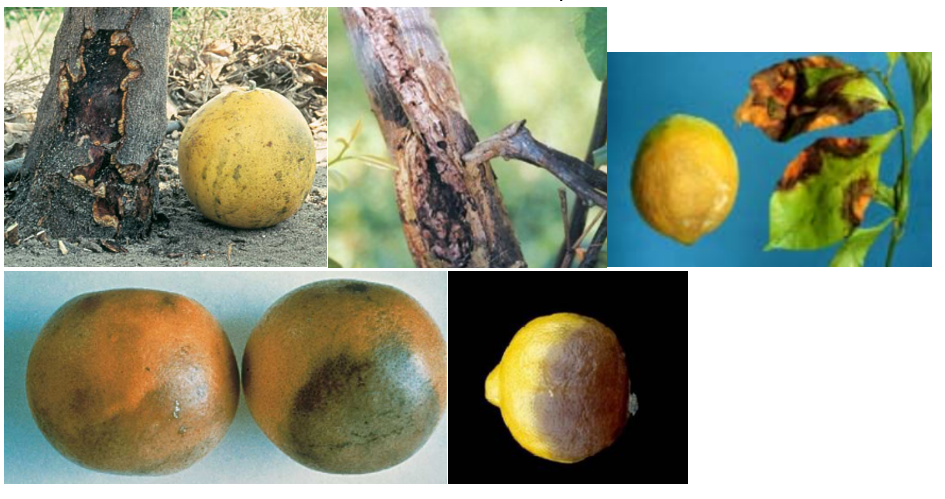
Foot Rot – Brown Rot – Crown Rot and Gummosis
2. Mal Secco
What is Mal secco disease in citrus trees?
Mal secco (Italian for dry disease) is caused by the imperfect fungus, Phoma tracheiphila. It is confined to citrus-growing regions of the Mediterranean Basin, the Black Sea, and Asia Minor. Species of Poncirus (orange variety), Severinia (Chinese box orange), Fortunella (Malayan kumquat), and citrus (lemon varieties) are susceptible.
Still, Citrus limon (common lemon) is particularly vulnerable to this vascular disease (xylem & phloem vessels that carry fluids). The mode of action of P. tracheiphila comprises the dispersal of its spores in the rain. The spores germinate on the leaves and enter the leaf tissue through the stomata (pores in the epidermis of leaves that provide gas exchange) or through wounds. Once the fungus reaches the xylem (vessels that uptake water), it spreads everywhere within the plant. Since the water-carrying vessels are infected, the citrus is no longer receiving adequate hydration resulting in wilting of branches.
What are the common symptoms of Mal secco in citrus? – How to detect Mal Secco on citrus trees?
Symptoms of the disease include veinal chlorosis, leaf wilk, and dieback of twigs and branches. If the tree remains untreated during the last stages of infection, the bark raptures and exposes numerous black fungal spores. At this stage, the death of the tree is imminent. Unfortunately, two other forms of this disease have been documented. Mal fulminate is a rapidly fatal form of P. tracheiphila that occurs when the fungus infects the base of the trunk or the tree’s roots. Mal nero is a chronic infection characterized by the browning of the heartwood (darker inner wood of the trunk).
Longitudinal sections across the twigs reveal a characteristic salmon-pink or orange-reddish discoloration of the wood associated with gum production.

Mal secco disease in citrus trees
How to prevent and treat Mal secco–infected citrus trees?
- Prune tree shoots and branches that bear fungal spores
- Remove suckers
- Spray with fungicides
- Early diagnosis can prevent spreading
Other soilborne fungal pathogens such as Pythium spp., Thielaviopsis basicola, Armillaria mellea, and Diplodia matalensis affect citrus trees and decrease their yields. However, they are considered minor root pathogens that can potentially cause problems under favorable environmental conditions.
3) Dry Root Rot
What is Dry Root Rot, and how does it affect citrus trees?
Dry Root Rot is a soilborne disease caused by the fungus Fusarium solani, which is very widespread and problematic on citrus trees. Cases have been found almost worldwide, including Australia, Europe, North America, South Africa, and India. This fungus is a primary colonizer of fibrous root systems, which rot and turn black after infection. The fungus excretes powerful toxins which are transported through the xylem (water uptake vessels of trees), and plug vessels, reduce water uptake, cause veinal chlorosis, leaf wilt, and the accumulation of zinc in the truck wood of citrus trees, which is also toxic. After initial infection by F. solani, other pathogens find their way in, such as Phytophthora spp. and nematodes, which exacerbate disease symptoms. F. solani disease occurs in groves with heavy soils that retain high levels of moisture all year round. Maintaining favorable soil conditions for healthy root growth is suggested to manage this disease. These include amending the soil composition with mineral rocks that allow airflow and prevent compaction, such as zeolite and attapulgite clay. If the fungus shows resistance and reappears, fungicides might need to be applied to save the yield and consequently the citrus trees.
How to detect Dry Root Rot on citrus trees?
Early detection is difficult because the disease first appears on the root system of the trees. Veinal chlorosis and leaf wilt appear at a later stage and are characteristic symptoms of the disease. Detection at this stage could save the tree after appropriate treatment.


How to treat Dry Root Rot – infected citrus trees?
- Amend the soil with vermicompost
- Add minerals that increase soil aeration, such as attapulgite
- Spray with fungicides
Post-Harvest Fungal Diseases of Citrus
Post-harvest fungal decays are also prevalent in citrus, and they depend on the:
- variety,
- weather conditions,
- degree of damage during harvest
- conditions of the post-harvest facility
Typically, pre-harvest pathogens, such as Colletotrichum gloeosporioides, infect fruits in the field between fruit set and harvest, but they then transition to necrotrophs (organisms that actively destroy host-tissue using toxins to feed) and, along with wound pathogens (e.g. Penicillium digitatum, P. italicum) attack fruits during post-harvest handling.
1. Alternaria Rot or Sooty Mold (Inner Black Rot)
What is Alternaria, and how does it affect citrus fruits?
Alternaria rot, or in other words, Sooty mold, is caused by the fungus Alternaria citri, which causes premature coloring of fruits on the trees and the development of light brown to black lesions of the rind (peel of fruit) and internal black discoloration, mainly along the central axis of the fruit during storage. This disease is mainly a stem-end rot of fruits that have been stored at low temperatures for long periods of time. A. citri exists saprophytically in orchards and produces airborne spores (conidia). The disease only develops following damage from sunburn, drought, frost, or over-maturity of the stylar end of the fruit (i.e. the naval).
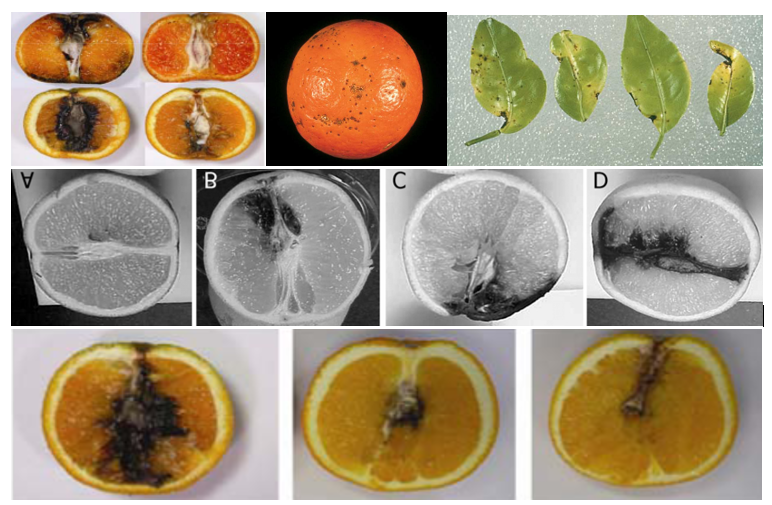
Alternaria rot in lemons
2. Anthracnosis in citrus trees
What is Anthracnose, and how does it affect citrus fruits?
Anthracnose or Lemon Scab disease is caused by the fungus Colleototrichum gloeosporioides (previously known as Glomerella cingulata). Species from the Sphaceloma genus of fungi can also cause this disease. It primarily affects bruised or damaged citrus fruits. Its fungal spores are spread by rain or overhead irrigation. They remain latent on the surface of the fruit and only germinate and become problematic when the fruit tissues are weakened. This weakening could be caused by pests, mechanical damage, chemical sprays, sunburn, or ethylene treatment during the degreening process of the harvested fruits. Anthracnose exhibits brown to black lesions about 1.5 cm in diameter on the rind of the fruits. The resulting decay is firm and dry, and softening of the fruit depends on the extent of invasion. Fungal spores display salmon-pink colors and are visible under humid conditions. 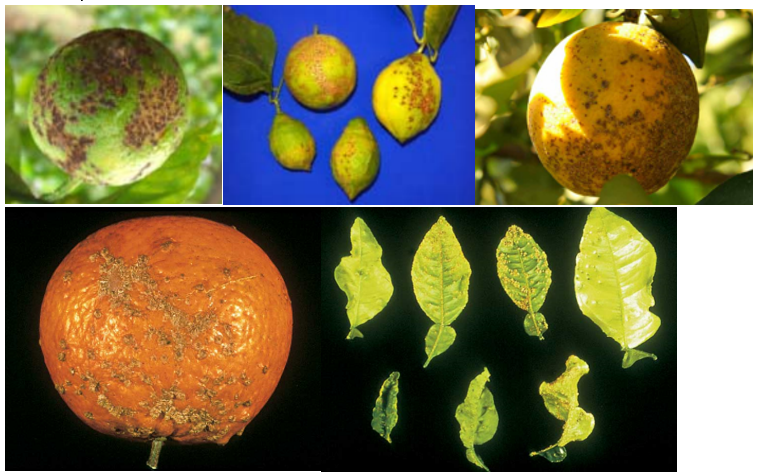
Anthracnosis in oranges
3. Diplodia Stem-end Rot
What is Diplodia stem-end rot, and how does it affect citrus fruits?
Diplodia stem-end rot is caused by the fungus Botryosphaeria rhodina. This saprophytic fungus lives on dead twigs in the field. Spores are either spread by rain splash over short distances or by air. Although the spores are deposited in the stylar region of the fruit while it is still in the tree, the pathogenes don’t enter the tissue until after harvest when the button (remnants of the floral calyx) is removed. Early removal of the button provides a site for fungal entry into the fruit under favorable conditions (temperature: > 21°C, humidity > 90%). Decay progresses unevenly over the fruit.
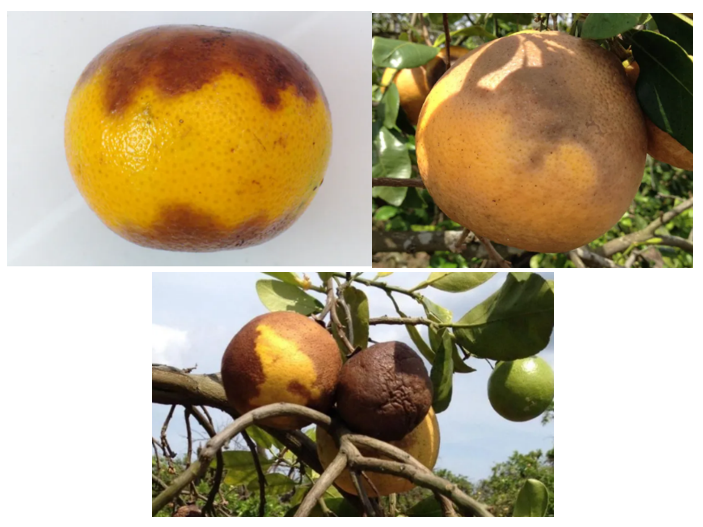
Diplodia Stem-end Rot in oranges
4. Gray Mold or Botrytis Blossom
What is Gray mold, and how does it affect citrus fruits?
Gray mold is a fungal disease caused by Botrytis cinerea (Botryotinia fuckeliana). Fungal spores produced on organic debris in the orchard are dispersed to flowers (Blossom blight) by wind or rain splash. Infected petals are the primary source of infection of fruit and twigs. It is difficult to identify the disease due to genetic and morphological variability. Citrus trees are the most affected out of the 200 host plants. The fungus creates gray mold associated with brown leathery decay of the fruits. Fruit set is reduced, and premature fruit drop is also common.
- A similar disease includes Postbloom Fruit Drop (PFD) caused by Colletotrichum acutatum. The disease appears as peach or brown-colored necrotic spots on the petals of citrus flowers. It induces fruit drop and forms persistent buttons (calyces), which remain attached to the stems of the trees. The damage is most severe on Valencia oranges but can be seen in most citrus species. PFD dispersal depends on humidity levels. The fungus also survives on the surface of leaves, twigs, and flowers.
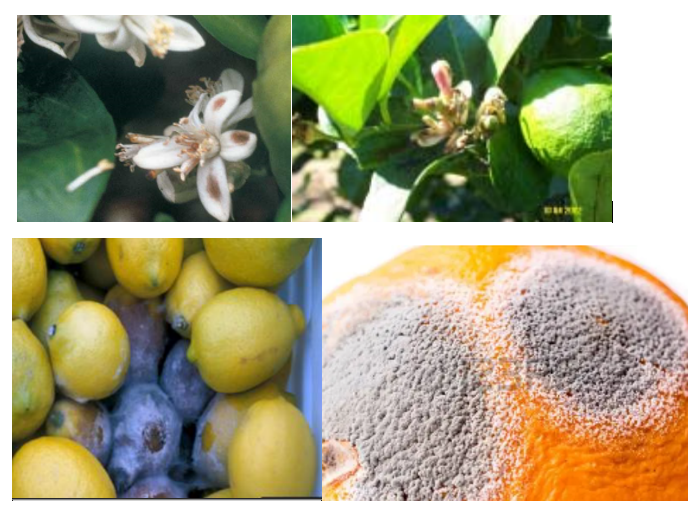
Gray Mold or Botrytis Blossom in citrus
5. Sour Rot
What is Sour Rot, and how does it affect citrus fruits?
Sour rot is caused by the Galactomyces citri–aurantii (anamorph Geotrichum citri–aurantii) fungus. It is regarded as the most unpleasant of all the citrus decays. The fungus is soilborne and spreads to fruits by wind and rain. Entry into the rind occurs through mechanical or insect injuries. G. citri–aurantii affects mature and over-mature lemons and is often found with P. digitatum and P. italicum pathogens. Disease symptoms include the initial development of water-soaked, light- to dark-yellow, slightly raised lesions, and, over time, the fruit disintegrates into a slimy, watery mass. 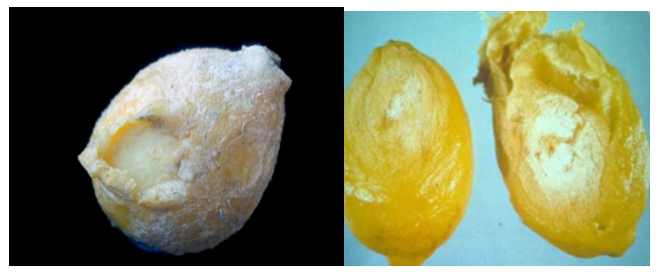
Sour rot in lemons
6. Green Mold
What is Green mold, and how does it affect citrus fruits?
Green mold is caused by the fungus Penicillium digitatum. The fungus acidifies the host tissue during decay development and actively takes up ammonium ions. Neutral pH plays a major role in regulating the spread of the disease. Fungal spores persist in orchards and are dispersed in air currents. They infect fruits through wounds and grow into powdery mycelium (roots of fungi). P. digitatum produces olive green sporulating areas hence its name. Once the fruit rots completely, it becomes dry. Green mold and Sour rot are the most economically important post-harvest citrus diseases in arid growing regions. 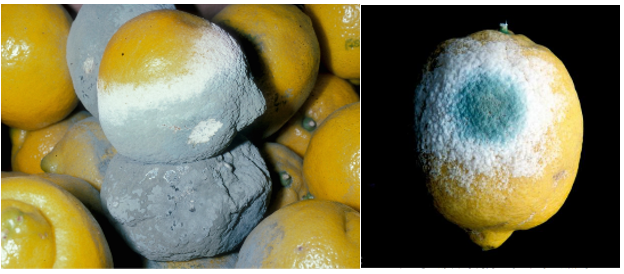
Green Mold in lemons
7. Blue Mold
What is Blue mold, and how does it affect citrus fruits?
Blue mold is caused by the fungus Penicillium italicum. It displays the same mode of action and infection as green mold. However, it grows better at lower temperatures (10°C) and is more readily dispersed in packing, storage, and transit facilities than P. digitatum.
Prevention and Treatment of Green and Blue mold in citrus trees
- Immersion of infected fruits in a fungicidal solution
- Fruits showing de-greening could be exposed to hot water treatment followed by treatment with ammonia
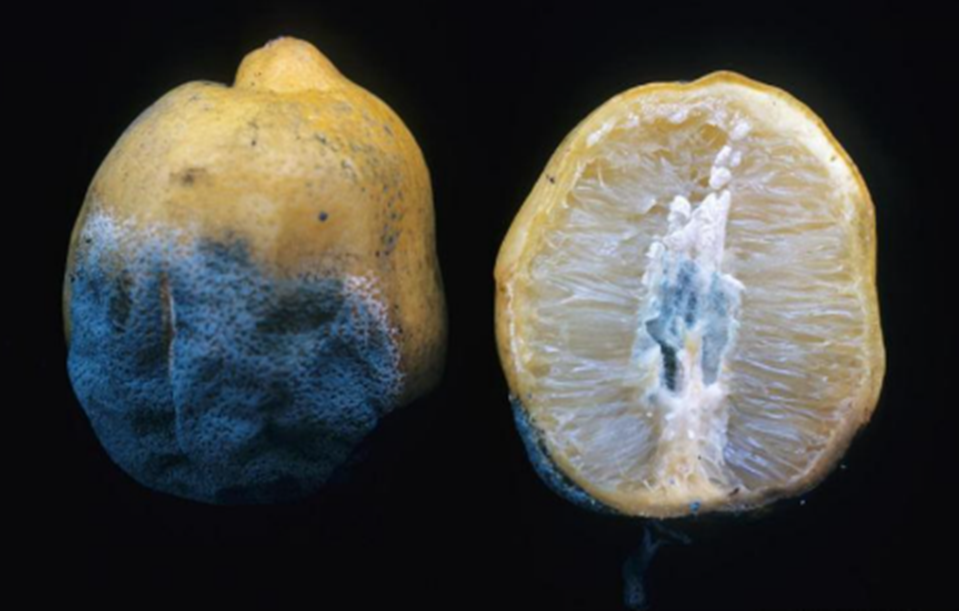
Blue mold in lemons
8. Black Mold
What is Black mold, and how does it infect citrus fruits?
Black mold is caused by the fungus Aspergillus niger. It survives saprophytically in the orchard, and air currents disperse the spores. Disease identification is similar to Sour rot and starts with the appearance of light-brown to orange-colored lesions that later become sunken as decay progresses. Eventually, soft decayed fruits are covered with black powdery layers of fungal spores. A. niger is generally problematic when fruits are held at high temperatures (> 15°C). Infection occurs through damage incurred during handling. The fungus secrets large amounts of acids that decay the fruit and compromise citrus fruit defenses.
How to treat fungal post-harvest diseases that occur on citrus fruits?
- Application of fungicides incorporated in fruit waxes, e.g., Fludioxonil
- Application of biological control agents such as Candida oleophila or Pseudomonas syringae
- Immerse fruit in sodium bicarbonate at ambient temperatures
- Heat fruit in sodium carbonate
- Heat fruit in borax and boric acid mixtures
- Biological control formulations using Bacillus spp., Pantoea agglomerans
- Application of ionizing radiation
Further reading
Fruit-tree related terminology and categorization – Pomology
The most Popular Lemon Tree Varieties
Lemon Tree Pruning for Optimal Growth and Yield
Nutrient needs and Fertilization of Lemon trees
Important Citrus Diseases caused by Fungi
Important Virus Diseases in Citrus trees
Bacterial Citrus Diseases: Identification and Control
References
- Brown GE, Eckert JW (2000b) Alternaria rot. In: Timmer LW, Garnsey SM, Graham JH (Eds) compendium of Citrus Diseases. American Phytopathological Society Press, St. Paul, MN, P37
- Erwin DC, Ribeiro OK (1996) Phytophthora Disease Worldwide, American Phytopathological Society, St. Paul, MN 562pp
- Ezrari, S., Lahlali, R., Radouane, N. et al. Characterization of Fusarium species causing dry root rot disease of citrus trees in Morocco. J Plant Diseases 128, 431–447 (2021).
- Fawcett HS, 1936. Citrus Diseases and their control, McGraw-Hill, New York, USE, 656 pp
- Graham JH (1995) Root regeneration and tolerance of citrus rootstocks to root rot caused by Phytophthora spp. relationship to citrus rootstock. Plant Disease 87, 85-90
- Graham JM, Menge JA (2002) Phytophthora-induced disease. Timmer LW, Garnsey SM, Graham JH Compendium of Citrus Disease, American Phytopathological Society Press, St. Paul, MN, pp 12-15
- Grimm GR, Alexander AF (1973) Citrus leaf pieces as traps for Phytophthora parasitica from soil slurries. Phytopathology, 63, 540-541
- Growing lemons in Australia, A production Manual, Reader’s note. http://www.dpi.nsw.gov.au/agriculture/horticulture/citrus/lemon-manual
- https://agritech.tnau.ac.in/crop_protection/crop_postharvest_citrus_4.html
- https://apps.lucidcentral.org/pppw_v10/text/web_full/entities/citrus_storage_moulds_197.htm
- https://blog.pestprophet.com/botrytis-diseases-citrus/
- https://citrusindustry.net/2022/09/06/controlling-diplodia-ser-on-grapefruit/
- https://idtools.org/citrus_diseases/index.cfm?packageID=2&entityID=176
- https://www.forestryimages.org/browse/detail.cfm?imgnum=1570565
- https://www.invasive.org/browse/detail.cfm?imgnum=1570473
- https://www.ipmimages.org/browse/detail.cfm?imgnum=1570809
- İnci Güler Güney, Fatih Tekin, Tacettin Utku Günen, Göksel Özer, Sibel Derviş, Alternaria alternata causing inner black rot of lemon (Citrus limon) fruits in Turkey: Genetic diversity and characterization, Physiological and Molecular Plant Pathology, Volume 125, 2023, 101998, ISSN 0885-5765
- Katoh et al. 2006. A virulence–reducing mutation in the postharvest citrus pathogen Alternaria citri. Population Biology. Japan Science and Technology agency.
- Peever et al., 2005. Citrus Black Rot is Caused by Phylogenetically Distinct Lineages of Alternaria alternata. Population Biology, University of Floride
- Ricci P, Pope de Vallavielle C, Panabiere F, Marais A, Auge G (1990) caractères compares des especies de Phytophthora pathogenes des agrumes. EPPO Bulletin 20, 19-28
- Said Ezrari, Nabil Radouane, Abdessalem Tahiri, Zakaria El Housni, Fouad Mokrini, Göksel Özer, Abderrahim Lazraq, Zineb Belabess, Said Amiri, Rachid Lahlali, Dry root rot disease, an emerging threat to citrus industry worldwide under climate change: A review, Physiological and Molecular Plant Pathology, Volume 117, 2022, ISSN 0885-5765
- Sharma, Priyanka & Roy, Monish & Roy, Bidhan. (2021). A Brief Overview of Major Citrus Diseases and Pests and Its Management. 10.9734/bpi/ctas/v1/13548D.
- Solel Z, Salerno M, 2000, Mal Secco. In Timmer LW, Gransey SM, Graham JH (Eds) Compendium of Citrus Diseases, Americal Phytopathological Society Press, St. Paul, MN, pp33-35
- Stephen, H. Futche and Timmer L., W. 2008, A guide to citrus disease identification, Institute of food and agricultural sciences, University of Florida.
- Tennant et al., 2009. Global Science Books, Tree and Forestry Science and Biotechnology.


















